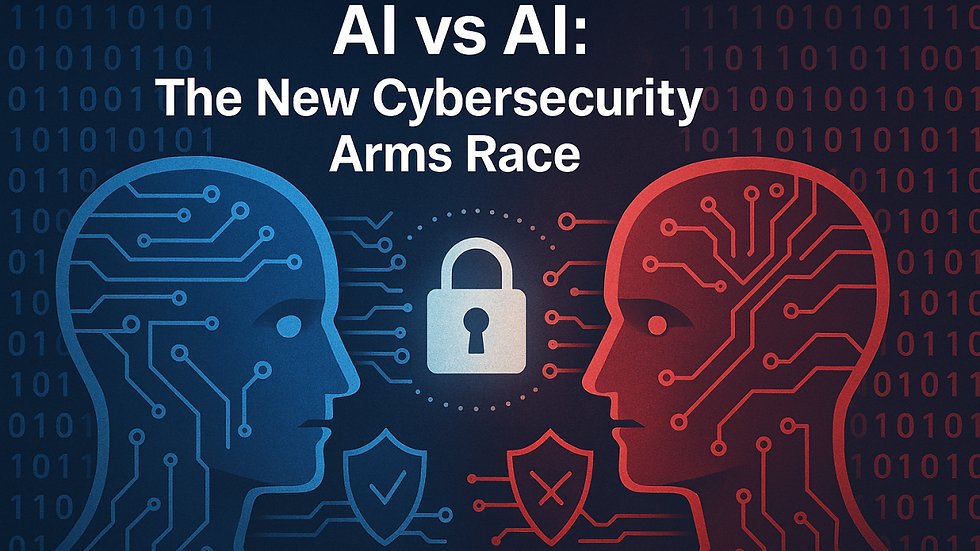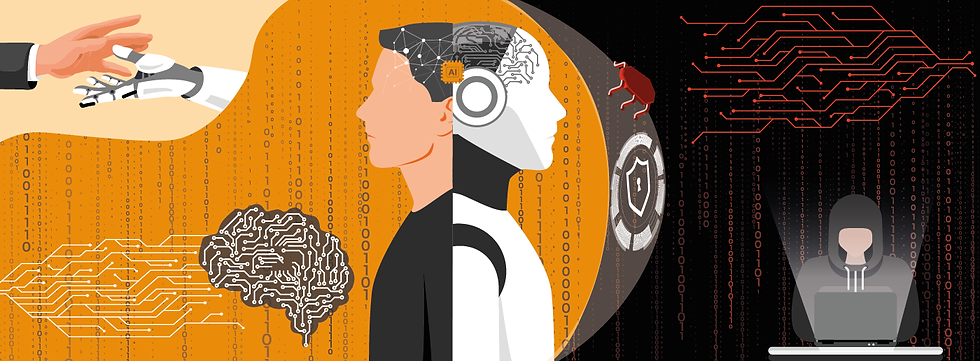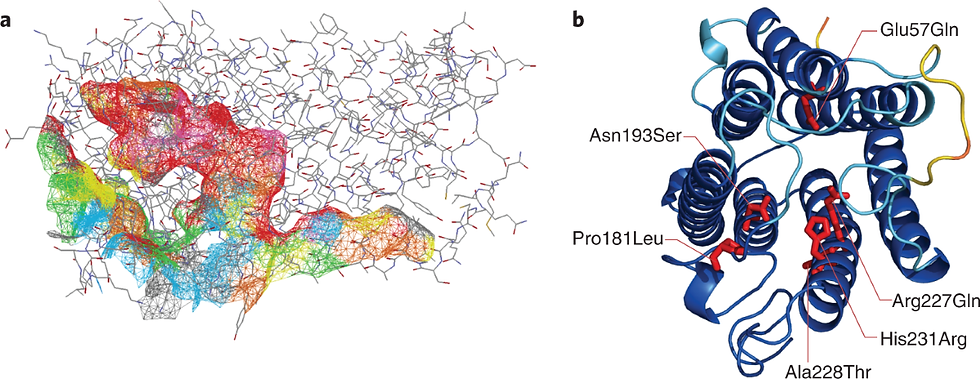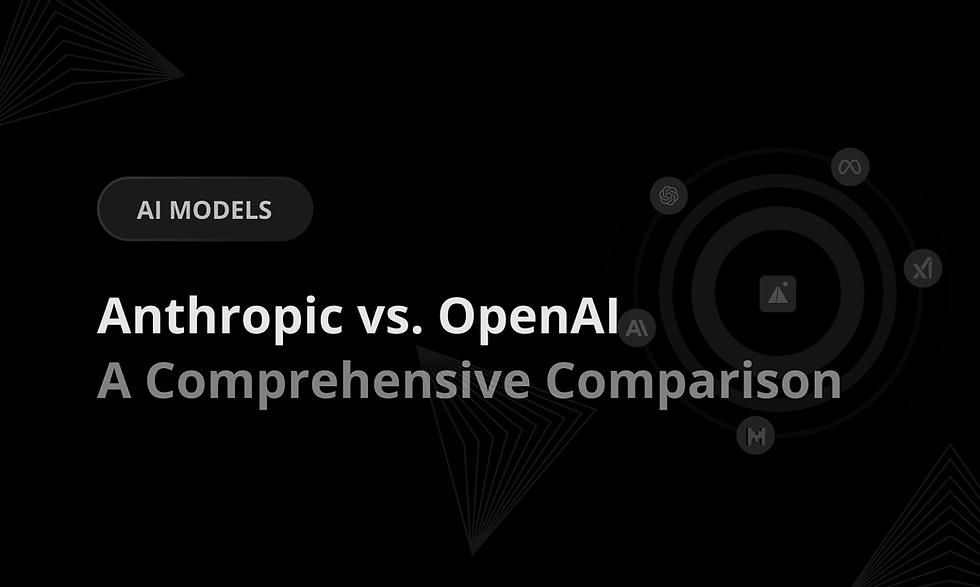The AI Cybersecurity Arms Race: How Hackers and Defenders Are Battling with Algorithms
- Olivia Johnson

- Aug 18
- 10 min read

The AI Cybersecurity Arms Race refers to the escalating contest between attackers and defenders leveraging artificial intelligence (AI) and machine learning (ML) technologies to gain advantage in cyberspace. As AI capabilities rapidly evolve, enterprises, governments, and critical infrastructure face unprecedented challenges where both sides deploy increasingly sophisticated algorithms to outmaneuver one another. This arms race is not just a technical competition; it directly impacts national security, business continuity, and public trust.
Generative AI and automation have transformed cybersecurity tactics. Attackers harness AI to automate reconnaissance, craft personalized phishing attacks, and develop novel malware. Meanwhile, defenders deploy AI-powered Security Operations Centers (SOCs) and anomaly detection tools to identify and respond to threats faster than ever. The dynamic interplay of offense and defense powered by AI is reshaping the cybersecurity landscape.
This article explores the evolution, offensive and defensive tactics, model vulnerabilities, policy responses, community efforts, and practical best practices related to the AI Cybersecurity Arms Race. It is essential reading for CISOs, security teams, policymakers, and anyone invested in understanding how AI reshapes digital defense. For a detailed perspective on this evolving contest, see Security Magazine's analysis of AI defenders in evolving threats and Axios’s insights on how generative AI changes cybersecurity attacks.
Background & Evolution of the AI Cybersecurity Arms Race

The AI Cybersecurity Arms Race has evolved through several key milestones that have shifted the power balance between attackers and defenders. Initially, machine learning was primarily a defensive tool—used to detect anomalies and malicious activity. Over time, research into adversarial machine learning revealed vulnerabilities that attackers could exploit, marking a turning point in cybersecurity dynamics.
The timeline begins with early ML detection systems in the 2010s, progresses through adversarial ML research in the late 2010s and early 2020s, and culminates in the recent widespread availability of large-scale generative models. This availability has dramatically increased both the scale and sophistication of cyberattacks while also enhancing defensive automation capabilities.
Academic research laid the foundation for this arms race by exposing model weaknesses that foreshadowed today's offensive and defensive strategies. The scaling of generative AI models has amplified risks but also accelerated innovation in defensive AI tooling, creating a complex battleground where each side continuously adapts.
Early ML and Adversarial Research That Started the AI Cybersecurity Arms Race
Early research into adversarial examples—inputs designed to deceive ML models—highlighted fundamental vulnerabilities in AI systems. Seminal papers such as "Exploring Adversarial Examples and Robustness" demonstrated how small perturbations could cause models to misclassify data, exposing attack vectors against AI defenses.
This theoretical work revealed that ML models themselves could become targets or tools in attacks. For example, attackers might poison training data or craft inputs that evade detection by anomaly systems. These insights foreshadowed a cybersecurity landscape where model-targeted attacks would become central to both offensive campaigns and defensive countermeasures.
From ML Detection to Generative-Powered Escalation
Initially used for threat detection, ML has evolved into a dual-use technology driving both offense and defense. Defenders integrate AI into Security Operations Centers (SOCs) for faster threat hunting and incident response. Conversely, attackers exploit generative AI to automate reconnaissance, craft sophisticated phishing messages, and develop novel malware variants.
The rise of large generative models has introduced generative risk, where attackers can mass-produce customized exploits or social engineering campaigns at scale. Market demand for advanced security tools has pushed vendors to innovate rapidly, intensifying this escalation.
For example, platforms like Dropzone’s AI SOC illustrate how automated detection is transforming defense operations. Meanwhile, policy experts highlight the urgency of improving cybersecurity for AI systems themselves as foundational to managing this arms race.
Offensive Tactics: How Hackers Use AI in the AI Cybersecurity Arms Race

AI-powered offensive tactics enable hackers to amplify their objectives across scale, personalization, evasion, and direct attacks on ML models themselves. Understanding these tactics helps organizations anticipate threats and prioritize defenses.
Offensive AI Capabilities at a Glance
Automation & Scale: Rapid reconnaissance, exploit generation, attack pipeline orchestration.
Social Engineering: Personalized spearphishing campaigns using prompt-driven language models.
Adversarial Attacks: Model evasion via crafted inputs or data poisoning.
Model-Targeting Attacks: Extraction of proprietary models or membership inference.
Below is a simplified risk matrix illustrating common offensive tactics by their likelihood and impact on enterprises and infrastructure:
Offensive Tactic | Likelihood | Impact |
|---|---|---|
Automated reconnaissance & phishing | High | Medium-High |
Generative malware & exploit code | Medium | High |
Adversarial ML evasion & poisoning | Medium | Medium |
Model extraction & theft | Low-Medium | High |
Automated Reconnaissance, Phishing and Social Engineering at Scale
AI-driven prompt engineering allows attackers to personalize spearphishing emails with unprecedented accuracy. By ingesting publicly available information through automated OSINT (Open Source Intelligence), attackers craft messages that mimic tone and context specific to their targets.
These automated pipelines increase attack throughput, allowing hackers to launch thousands of tailored phishing attempts simultaneously. For instance, recent CISA advisories (AA25-142A) detail how threat actors leverage AI-generated content to bypass traditional filters and increase click rates.
Insight: Organizations must enhance email filtering with behavioral analysis capable of detecting subtle anomalies beyond keyword spotting.
Generative AI for Malware, Code-Synthesis and Attack Tooling
Large language models (LLMs) can write or modify malicious code snippets on demand. Hackers use generative AI to develop polymorphic malware that evades signature-based detection by constantly changing its structure.
Common malware use-cases enabled by generative AI include:
Crafting obfuscated payloads
Generating zero-day exploit scripts
Automating lateral movement tools
This automation overwhelms defenders with noisy alerts, making it harder to distinguish genuine threats from false positives or benign anomalies.
Adversarial ML and Model-Targeted Attacks in the Arms Race
Attackers also directly target machine learning models through adversarial examples, data poisoning, model extraction, or membership inference. These attacks compromise model integrity or leak sensitive training data.
For example:
Data poisoning: Injecting malicious samples during training to bias model behavior.
Model extraction: Reverse-engineering proprietary models via repeated queries.
Membership inference: Inferring whether specific data points were part of training datasets.
Such attacks threaten the ML supply chain, requiring defenders to harden models with robust validation and continuous monitoring.
Defensive Strategies & Best Practices for the AI Cybersecurity Arms Race

Defenders need a unified playbook combining detection, response, resilience, and secure ML lifecycle management. Balancing automation with human oversight is critical to avoid blind spots or overreliance on opaque AI decisions.
AI-Powered SOCs and Detection: Defensive AI in Practice
AI augments SOC analysts by enabling:
Anomaly detection that identifies unusual network or user behavior.
Triage prioritization to focus analyst attention on high-risk alerts.
Threat hunting automation for proactive exploration of hidden threats.
However, trade-offs include false positives, model drift as attacker behaviors evolve, and the need for transparency so analysts can trust AI recommendations. Organizations should implement regular model retraining and maintain human-in-the-loop processes to ensure accountability.
Best Practice: Combine automated detection with analyst validation to maximize effectiveness while minimizing alert fatigue.
Government Initiatives and Funded Programs Defending the AI Cybersecurity Arms Race
Government programs like DARPA's cybersecurity challenges accelerate development of defensive AI tools that can detect emerging threats at scale. These initiatives provide funding and frameworks encouraging vendors to innovate secure-by-design solutions.
DARPA’s efforts promote collaboration between academia, industry, and government agencies, shaping research priorities and vendor roadmaps toward resilient AI defenses.
Defensive Best Practices and Secure AI Lifecycle
Defenders should operationalize security through controls such as:
Secure data pipelines ensuring input integrity
Rigorous model validation against adversarial inputs
Continuous monitoring of deployed models
Strict access controls limiting model modification
Regular red-team exercises simulating attacks on AI systems
Governance frameworks must embed change management processes and incident playbooks incorporating human-in-the-loop enforcement.
Checklist Lead-In: Implementing these controls creates a holistic secure AI system development lifecycle essential for resilience.
Model Security & Vulnerabilities at the Heart of the AI Cybersecurity Arms Race

AI models themselves are high-value targets vulnerable to exploitation through jailbreaks, prompt injections, theft, or unsafe outputs that can degrade system trust or cause cascading failures within downstream applications.
Jailbreaking, Prompt Injection and Real-World Model Exploits
Jailbreaking refers to techniques that bypass model safety filters or content restrictions by manipulating input prompts. Prompt injection involves injecting malicious instructions into inputs that cause unintended behaviors.
Notable incidents involving GPT-5 jailbreaks demonstrate how attackers can coerce models into generating harmful content or revealing sensitive information. These exploits threaten organizational confidentiality, regulatory compliance, and user safety.
Risk Statement: Unmitigated model exploits undermine trust in deployed AI systems and can lead to reputational damage or legal liability.
Securing Model Development, Deployment and Monitoring
Mitigation involves practical steps such as:
Ensuring data provenance to validate training dataset origins
Applying model validation techniques including adversarial testing before deployment
Implementing runtime monitoring for anomalous model outputs
Establishing patching procedures to update models based on threat intelligence
Enforcing organizational governance aligned with regulatory standards for secure AI system development
Policy, Governance and Market Responses to the AI Cybersecurity Arms Race

National policies, vendor frameworks, and market forces significantly influence defensive capabilities by setting expectations around risk tolerance, compliance, procurement decisions, and innovation incentives.
National Strategy, Executive Orders and Coordinated Policy Responses
Recent executive actions such as The White House’s 2025 Executive Order on strengthening cybersecurity innovation prioritize secure-by-design principles for AI vendors and government agencies alike.
This policy accelerates adoption of defensive AI technologies while mandating transparency and risk management protocols at scale.
“We must ensure our digital infrastructure is resilient against emerging threats posed by increasingly capable adversaries leveraging artificial intelligence.” — White House Executive Order (2025)
Industry Frameworks, Vendor Guidance and Technical Standards
Vendor-led frameworks like Google's securing AI framework guide enterprises in adopting secure AI practices that harmonize with evolving standards from bodies such as the Cloud Security Alliance.
These frameworks promote consistency across diverse organizational environments while influencing vendor product roadmaps toward stronger security postures.
Market Adoption, Vendor Landscape and Business Risk
The market for AI-powered security solutions is rapidly expanding as organizations prioritize automation amid complex threat landscapes.
Buyers assess vendors based on factors such as:
Integration capabilities
Proven detection efficacy
Compliance with regulatory frameworks
ROI through reduced incident response times
Vendor assessment checklists help organizations navigate this fast-growing ecosystem effectively.
Case Studies, Community Response and Lessons from the AI Cybersecurity Arms Race

Real-world examples illustrate both attacker successes exploiting emerging weaknesses and defender wins driven by innovation and collaboration.
GPT-5 Jailbreak — A Warning from the Front Lines
The GPT-5 jailbreak incident involved sophisticated prompt injections that bypassed content filters leading to unsafe outputs. This event exposed gaps in model safety engineering but also highlighted rapid disclosure protocols and patch deployment as critical mitigation steps.
Key lessons:
Speed matters in vulnerability disclosure.
Transparent communication builds user trust.
Continuous model hardening is essential post-deployment.
DARPA Challenge and Community Initiatives Like DEF CON Franklin
DARPA’s cybersecurity challenge advanced defensive AI tooling by incentivizing innovative algorithm development aimed at real-time threat detection.
Complementary grassroots efforts such as DEF CON Franklin mobilize volunteer expertise around securing critical U.S. infrastructure like water systems—demonstrating how community cybersecurity initiatives bolster national resilience.
Coordinated Advisories and Incident Response Examples
Agencies like CISA issue coordinated advisories (e.g., AA25-142A) that disseminate emerging threat intelligence across sectors. Enterprises benefit by integrating these advisories into Cyber Threat Intelligence (CTI) ingestion pipelines enabling timely protective actions.
Takeaway: Maintaining subscription to cross-sector advisories enables proactive defense posture adjustments before widespread exploitation occurs.
Actionable Best Practices: Defend and Prepare for the AI Cybersecurity Arms Race

To harden defenses against evolving threats in the AI Cybersecurity Arms Race, CISOs should implement prioritized best practices focused on secure development, operational readiness, governance, and workforce enablement.
Practical Controls for Secure AI Development and Deployment
Implement these core controls aligned with secure AI system development principles:
Enforce strict data governance ensuring provenance integrity.
Apply input sanitization to prevent injection-based attacks.
Conduct rigorous model validation including adversarial robustness testing.
Enable continuous monitoring with KPIs tracking anomaly rates and false positives.
Example KPIs include:
KPI | Target Threshold |
|---|---|
False Positive Rate | <5% |
Detection Latency | <1 minute |
Model Drift Frequency | Monthly retraining |
Operational Measures for SOCs and Incident Response
Best practices include:
Deploying AI-powered detection with mandatory human validation steps.
Automating triage workflows while preserving analyst oversight.
Maintaining incident playbooks tailored for model-related misuse.
Establishing rollback or kill-switch procedures enabling rapid containment.
Governance, Procurement and Workforce Readiness
Organizations should:
Conduct rigorous vendor risk assessments incorporating contractual security SLAs.
Align procurement processes with evolving policy mandates and industry standards.
Invest in continuous staff training programs focusing on emerging AI threats.
This approach reduces supply-chain risks while preparing teams for future challenges.
FAQ: Common Reader Questions About the AI Cybersecurity Arms Race
Q1: What is the "AI Cybersecurity Arms Race," and why should my organization care?
A1: It is the ongoing competition where attackers and defenders use AI tools to outsmart each other. Your organization is at risk because both cyberattacks and defenses are becoming more automated and sophisticated.
Q2: Can AI help defenders catch up with attackers?
A2: Yes; AI-powered SOCs improve detection speed and accuracy but require human oversight to manage false positives.
Q3: Are current models safe to use in production?
A3: Models have vulnerabilities like prompt injection but following secure development guidelines reduces these risks significantly.
Q4: How should we respond to a model jailbreak or prompt-injection incident?
A4: Rapid disclosure, patching affected models, updating filters, and communicating transparently are key steps.
Q5: What regulations or standards should we watch?
A5: Follow national executive orders promoting secure-by-design approaches alongside vendor frameworks like Google's securing AI framework.
Q6: How do we evaluate AI cybersecurity vendors?
A6: Assess based on integration capabilities, compliance adherence, proven efficacy, and vendor transparency.
Q7: What role do government programs like DARPA play?
A7: They fund research challenges accelerating defensive tool development for emerging threats.
Q8: How can small organizations defend critical systems with limited budgets? A8: Leverage community resources like coordinated advisories from CISA, adopt open-source tools where possible, and focus on staff training around social engineering risks.
Conclusions and Future Outlook: Staying Ahead in the AI Cybersecurity Arms Race

The AI Cybersecurity Arms Race underscores the dual-use nature of artificial intelligence—simultaneously empowering attackers while offering defenders powerful tools for protection. Success requires layered defenses integrating automation with human expertise alongside robust governance frameworks grounded in national policies promoting secure-by-design principles.
Emerging research on model-targeted attacks signals continued evolution in threat sophistication demanding proactive investment in adversarial testing, continuous monitoring, and incident readiness. Furthermore, coordinated community efforts—from government programs like DARPA challenges to volunteer initiatives—will remain vital pillars of cyber resilience.
Final Recommendations for Leaders:
Adopt a secure AI system development lifecycle: Prioritize data integrity, adversarial robustness testing, monitoring, and governance controls.
Balance AI automation with human oversight: Empower SOC teams with AI tools but preserve analyst validation workflows.
Engage proactively with policy frameworks: Align procurement, compliance strategies, and vendor assessments with evolving national standards.
By embracing these strategies today, organizations position themselves not just to defend but to lead in this rapidly shifting cybersecurity landscape shaped by artificial intelligence.
This article integrates insights from leading sources including Security Magazine’s coverage of evolving threats, Axios’s reporting on generative AI attacks, government advisories like CISA’s AA25‑142A, research from arXiv, as well as strategic guidance from Brookings and Cyber.gov.au.


